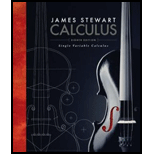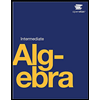T Diagonostic Tests 1 Functions And Limits 2 Derivatives 3 Applications Of Differentiation 4 Integrals 5 Applications Of Integration 6 Inverse Functions: Exponential, Logarithmic, And Inverse Trigonometric Functions 7 Techniques Of Integration 8 Further Applications Of Integration 9 Differential Equations 10 Parametric Equations And Polar Coordinates 11 Infinite Sequences And Series A Numbers, Inequalities, And Absolute Values B Coordinate Geometry And Lines C Graphs Of Second-Degree Equations D Trigonometry E Sigma Notation F Proofs Of Theorems G Complex Numbers expand_more
11.1 Sequences 11.2 Series 11.3 The Integral Test And Estimates Of Sums 11.4 The Comparison Tests 11.5 Alternating Series 11.6 Absolute Convergence And The Ratio And Root Tests 11.7 Strategy For Testing Series 11.8 Power Series 11.9 Representations Of Functions As Power Series 11.10 Taylor And Maclaurin Series 11.11 Applications Of Taylor Polynomials Chapter Questions expand_more
Problem 1E: (a) What is a sequence? (b) What does it mean to say that limn an = 8? (c) What does it mean to say... Problem 2E Problem 3E Problem 4E Problem 5E Problem 6E Problem 7E Problem 8E Problem 9E Problem 10E Problem 11E Problem 12E Problem 13E Problem 14E Problem 15E Problem 16E Problem 17E Problem 18E Problem 19E Problem 20E: Calculate, to four decimal places, the first ten terms of the sequence and use them to plot the... Problem 21E Problem 22E Problem 23E Problem 24E: Determine whether the sequence converges or diverges. If it converges, find the limit. 24.... Problem 25E: Determine whether the sequence converges or diverges. If it converges, find the limit. 25. an=n4n32n Problem 26E: Determine whether the sequence converges or diverges. If it converges, find the limit. 26. an = 2 +... Problem 27E: Determine whether the sequence converges or diverges. If it converges, find the limit. 27. an = 3n7n Problem 28E: Determine whether the sequence converges or diverges. If it converges, find the limit. 28. an=3nn+2 Problem 29E: Determine whether the sequence converges or diverges. If it converges, find the limit. 29. an=e1/n Problem 30E: Determine whether the sequence converges or diverges. If it converges, find the limit. 30. an=4n1+9n Problem 31E: Determine whether the sequence converges or diverges. If it converges, find the limit. 31.... Problem 32E: Determine whether the sequence converges or diverges. If it converges, find the limit. 32.... Problem 33E: Determine whether the sequence converges or diverges. If it converges, find the limit. 33.... Problem 34E: Determine whether the sequence converges or diverges. If it converges, find the limit. 34. an =... Problem 35E: Determine whether the sequence converges or diverges. If it converges, find the limit. 35. an=(1)n2n Problem 36E: Determine whether the sequence converges or diverges. If it converges, find the limit. 36.... Problem 37E: Determine whether the sequence converges or diverges. If it converges, find the limit. 37.... Problem 38E: Determine whether the sequence converges or diverges. If it converges, find the limit. 38. {lnnln2n} Problem 39E: Determine whether the sequence converges or diverges. If it converges, find the limit. 39. {sin n} Problem 40E: Determine whether the sequence converges or diverges. If it converges, find the limit. 40. an=tan1nn Problem 41E: Determine whether the sequence converges or diverges. If it converges, find the limit. 41. {n2en} Problem 42E: Determine whether the sequence converges or diverges. If it converges, find the limit. 42. an = ln(n... Problem 43E Problem 44E Problem 45E: Determine whether the sequence converges or diverges. If it converges, find the limit. 45. an = n... Problem 46E: Determine whether the sequence converges or diverges. If it converges, find the limit. 46. an = 2n... Problem 47E Problem 48E: Determine whether the sequence converges or diverges. If it converges, find the limit. 48. an=nn Problem 49E Problem 50E Problem 51E: Determine whether the sequence converges or diverges. If it converges, find the limit. 51. an =... Problem 52E: Determine whether the sequence converges or diverges. If it converges, find the limit. 52.... Problem 53E Problem 54E: Determine whether the sequence converges or diverges. If it converges, find the limit. 54.... Problem 55E: Determine whether the sequence converges or diverges. If it converges, find the limit. 55. an=n!2n Problem 56E Problem 57E Problem 58E Problem 59E Problem 60E: Use a graph of the sequence to decide whether the sequence is convergent or divergent. If the... Problem 61E Problem 62E Problem 63E: Use a graph of the sequence to decide whether the sequence is convergent or divergent. If the... Problem 64E: (a) Determine whether the sequence defined as follows is convergent or divergent: a1 = 1 an+1 = 4 ... Problem 65E Problem 66E Problem 67E Problem 68E: Find the first 40 terms of the sequence defined by... Problem 69E: For what values of r is the sequence {nrn} convergent? Problem 70E Problem 71E Problem 72E: Determine whether the sequence is increasing, decreasing, or not monotonic. Is the sequence bounded?... Problem 73E Problem 74E Problem 75E: Determine whether the sequence is increasing, decreasing, or not monotonic. Is the sequence bounded?... Problem 76E: Determine whether the sequence is increasing, decreasing, or not monotonic. Is the sequence bounded?... Problem 77E Problem 78E: Determine whether the sequence is increasing, decreasing, or not monotonic. Is the sequence bounded?... Problem 79E Problem 80E Problem 81E: Show that the sequence defined by a1=1an+1=31an is increasing and an 3 for all n. Deduce that {an}... Problem 82E Problem 83E: (a) Fibonacci posed the following problem: Suppose that rabbits live forever and that every month... Problem 84E: (a) Let a1 = a, a2 =f(a), a3 = f(a2) = f(f(a)),, an+1 = f(an), where f is a continuous function. If... Problem 85E Problem 86E Problem 87E Problem 88E Problem 89E: Prove that if limn an = 0 and {bn} is bounded, then limn (anbn) = 0. Problem 90E: Let an(1+1n)n (a) Show that if 0 a b, then bn+1an+1ba(n+1)bn (b) Deduce that bn[(n + 1)a nb] ... Problem 91E: Let a and b be positive numbers with a b. Let a1 be their arithmetic mean and b1 their geometric... Problem 92E Problem 93E format_list_bulleted








